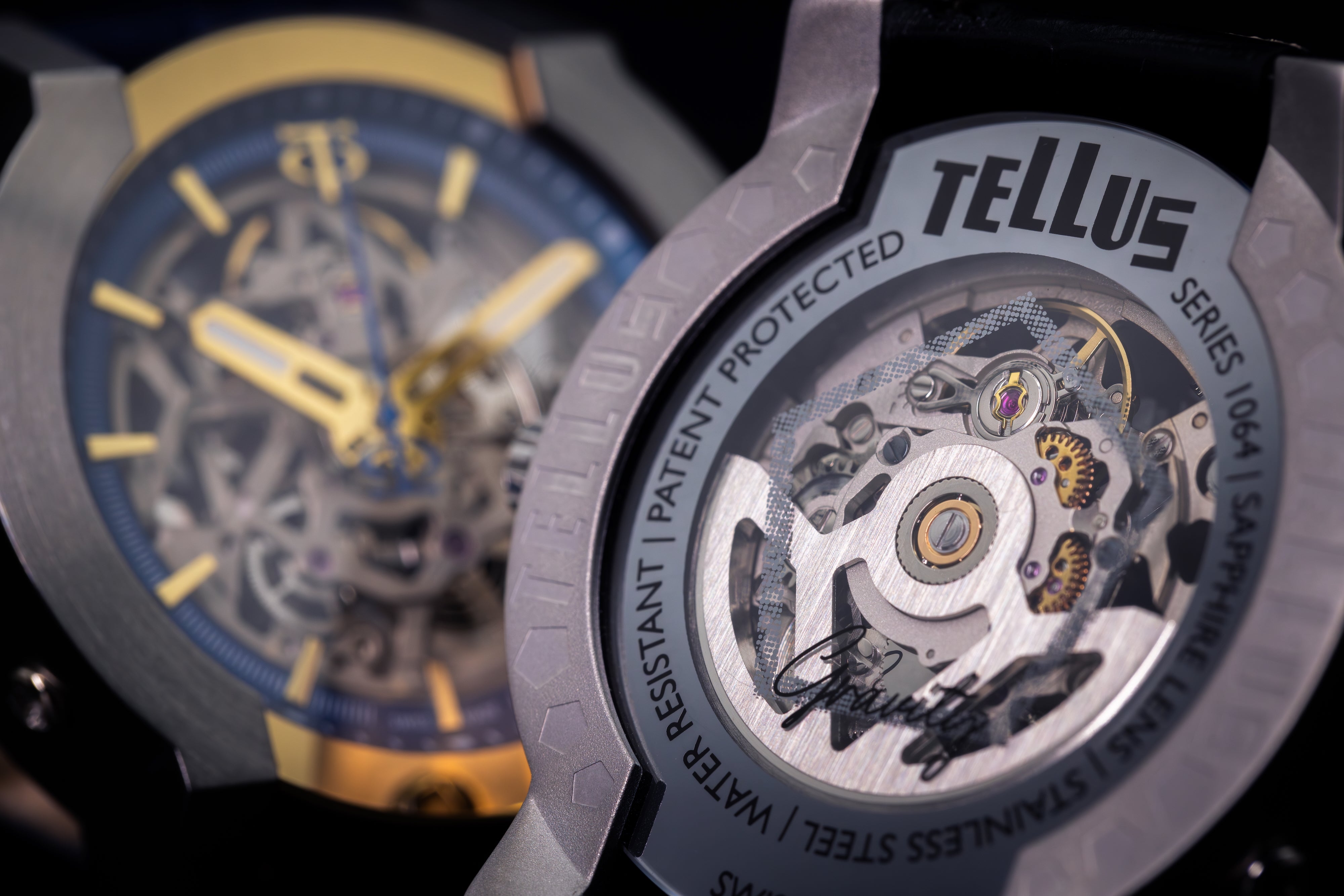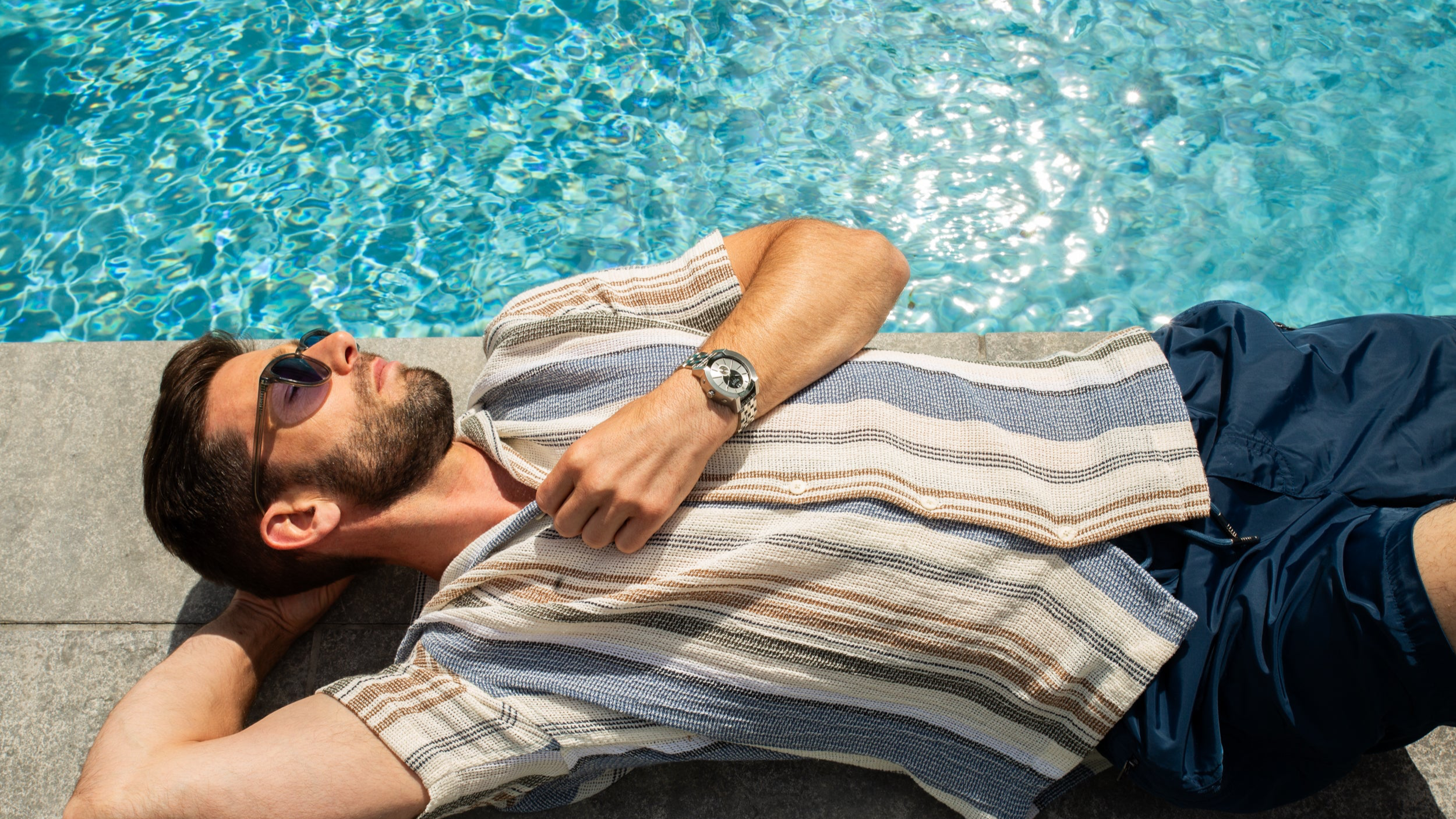Luxury Watch and Water Resistance: What You Need to Know Before Choosing
Water resistance in a luxury watch is never just a technical detail. It reflects the quality of craftsmanship, the precision of assembly, and sometimes even the longevity of the timepiece itself. Yet, this concept is often misunderstood. Does a "5 ATM" or "10 ATM" marking truly mean the watch can be submerged? Can you wear it in the shower, at the beach, or during a swim?
When choosing a high-end watch, it's not just about aesthetics or complications. It’s also about trust — in a piece designed to accompany your daily life in all its variety: from city living and travel to more demanding environments.
At Maison Tellus, each watch is designed with the rigor of Swiss Made standards, featuring clearly defined water resistance levels based on the model's intended use. From the subtle strength of the Stormer to the versatile elegance of the Discoverer, our timepieces incorporate expertly calibrated water resistance tailored to real-world conditions.
Yes to Water Resistance — But Which Level?
Not all watches are built to face water in the same way. That’s where the ATM rating comes into play — often engraved on the back of the case. This unit — atmospheres — indicates the maximum pressure the watch can withstand without compromising its water resistance. But beware: a high rating doesn’t necessarily mean the watch is suitable for diving.
A luxury watch marked 3 ATM can withstand a few splashes or light rain, but shouldn’t be submerged. At 5 ATM, it can handle a quick shower or brief swim — but not prolonged immersion. Only at 10 ATM does it become suitable for activities like swimming or regular use in fresh water. For intense water sports or diving, higher ratings are required — often paired with screw-down crowns and dedicated construction.
At Maison Tellus, each model undergoes thorough water resistance testing. Not to turn every watch into a dive instrument, but to ensure it withstands real-life scenarios: hand washing, rain, temperature shifts, or occasional immersion.
Can You Wear a Luxury Watch at the Beach or Pool?
Bringing a luxury watch on a seaside getaway or to the pool may seem like an easy choice. But behind this gesture lies a technical reality that’s often overlooked. The term "water-resistant" doesn’t necessarily mean the watch is designed to endure the combined effects of salt, sand, chlorine, or sudden temperature changes.
Saltwater is particularly corrosive, even to premium materials. Chlorinated water can degrade seals over time. And sun exposure followed by contact with cool water may cause uneven expansion of internal components — compromising the watch's integrity.
At Maison Tellus, certain models like the Discoverer are designed with calibrated resistance to support an active lifestyle — even by the water. Still, even the most robust watches should be treated with care: rinse with fresh water after exposure, dry thoroughly, and have water resistance checked regularly.
Which Luxury Watches Are Truly Water-Resistant?
Not all high-end watches aim for extreme use. A luxury water-resistant watch isn’t necessarily meant for professional diving. For many buyers, the priority is withstanding everyday conditions: rain, hand washing, or occasional submersion. True water resistance aligns with the lifestyle of its owner.
This philosophy guides Maison Tellus creations. Without aiming to compete with dive-watch standards, the brand designs timepieces to meet real-life expectations with precision. The Stormer, for example, offers carefully calibrated resistance, reinforced with durable materials and exquisitely refined assembly. Its ability to handle urban environments, travel, and changing climates makes it a watch built to last.
Water resistance in luxury watches isn’t a marketing promise. It’s a delicate balance of elegance, technical precision, and high standards — mastered only by a few.
Maintenance and Water Resistance Testing: The Watch Owner’s Best Habit
No matter how well-crafted, even a luxury watch is not immune to the effects of time. Water resistance is not permanent: seals wear down, minor shocks can affect closures, and temperature variations weaken materials. That’s why it's recommended to test your watch’s water resistance once a year at a certified watchmaker.
This test ensures your watch still holds pressure, identifies any weaknesses, and allows for replacement of sealing elements if needed. A simple step — but crucial to maintaining your luxury watch’s reliability, even with repeated water exposure.
Maison Tellus, in its commitment to customer care, always recommends regular maintenance. Members of the Collectors Club enjoy exclusive access to personalized advice, technical diagnostics, and maintenance services tailored to each model.

FAQ
What is the water resistance of luxury watches?
Water resistance is typically measured in ATM (atmospheres) or bars. A 3 ATM rating protects against splashes; 5 ATM allows light swimming or showering; 10 ATM and above support longer immersions. Always check the specific limits defined by the watchmaker.
How do you maintain a water-resistant watch?
Careful maintenance is essential. Rinse your watch with fresh water after exposure to salt or chlorine, avoid thermal shocks, and have the water resistance tested yearly by a certified professional. They can check pressure levels and replace seals if needed.
Which luxury watches are water-resistant?
Some watches are specifically designed for diving, like the Rolex Submariner or Omega Seamaster. Others, like Maison Tellus models, blend refined resistance with elegance — ideal for urban or on-the-go lifestyles.
What depth can a dive watch handle?
A professional dive watch offers at least 20 ATM (200 meters) of resistance. These models feature screw-down crowns and reinforced seals to ensure optimal water tightness under high pressure.
How do you check a watch’s water resistance?
Testing is done by a watchmaker using a pressure-testing machine. This quick process detects potential leaks and prevents damage. It’s best performed annually or before any repeated water exposure.
What materials are best for water-resistant watches?
Highly water-resistant watches are often made of stainless steel, titanium, or technical ceramics — materials that tolerate humidity, corrosion, and temperature changes well.
What are the best watches for swimming?
Watches rated at least 10 ATM are suitable for swimming. Rubber or metal bracelets are preferred over leather, which is more susceptible to water damage. Always ensure the crown is properly secured before diving in.





Leave a comment
This site is protected by hCaptcha and the hCaptcha Privacy Policy and Terms of Service apply.